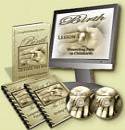You Want a Natural Vaginal Birth, But Have You Prepared for It?
Choosing
a Caregiver | Birth
Plan |
Settings
for Birth
Pregnancy Nutrition
| Body Preparation
| Exercise
| Breast
Feeding
When planning a natural vaginal birth, there is much to be considered. It is something that must actively be prepared for, in body, mind and spirit. Feeling overwhelmed? Don't worry; here's a step-by-step guide to the critical components in preparing for an optimal birth.
CARE PROVIDER

When choosing a natural vaginal birth, the most critical element is selecting a care provider. An obstetrician is only one of your choices. You may be able to select a family physician, a certified nurse midwife (CNM), a certified professional midwife (CPM) or a direct-entry midwife (DEM).
The role of a midwife is similar to that of a traditional OB with the most pertinent difference being that midwives are specialists in normal low-risk birth whereas obstetricians are primarily trained as surgeons to address complications. Another question to address is whether or not to hire a doula, a professional labor support person.
After you interview
each potential caregiver, your final decision should be based upon which provider shares your philosophy of childbirth and with whom you feel most comfortable.
For example, some obsetricians may schedule inductions to
avoid midnight
deliveries. If a care provider routinely induces, gives
episiotomies or
schedules c-sections, it will be much more difficult to have a natural vaginal birth under their care than with a practitioner who limits interventions, avoids scheduled c-sections, and waits for labor to begin on its own.
When you hire a medical
provider for your vaginal birth that is part of a larger group, ensure that all members
share like childbirth philosophies. Schedule a prenatal appointment with each one during your pregnancy so that you may familiarize them with your birth preferences in the event your chosen provider isn't available to attend your birth.
WRITING A BIRTH PLAN
Writing an interactive birth plan, which is essentially an outline of your "perfect world" delivery, is a concise, effective method of conveying your birth preferences to everyone who will be in attendance at your birth.
It's also crucial to include a contingency
plan in the event that complication arise, such as for an ill baby or an emergency c-section or transfer to a different facility. Expect the best vaginal birth, but thinking through alternate scenarios is a helpful tool in handling unforeseen circumstances, both mentally and emotionally, should they arise.
The most
important point to remember when constructing a
birthing plan is that it represents preferences.
Remaining open and flexible if events stray from your chosen path is essential.
SETTINGS FOR BIRTH
While a hospital delivery may seem the obvious choice, it may be surprising to realize that most people alive worldwide today were born at home. In addition to a home birth, a birth center may also be an optional setting to give birth.
Just like your choice of care provider, where you choose to give birth will have a direct impact on how your birth progresses. Research has shown that simply entering a hospital can make a woman's labor pattern become irregular, or even stop, secondary to the anxiety of entering that environment.
It's also important to note that policies vary from hospital to hospital. For example, some require mandatory newborn observation in the nursery for 4 hours after birth, require all newborn baby care procedures to be performed in the nursery without the parents present, or limit the number of birth companions during the birth. For these reasons, it is important to consider each hospital or birth center separately to ensure that your chosen place of birth aligns with your birth and newborn preferences.
Nutrition During Pregnancy
Nutrition during pregnancy is a vital factor, not only in maintaining a healthy pregnancy, but also in fostering optimal fetal development. As the average obstetrician spends less than 10 minutes per patient at each prenatal appointment, prenatal nutrition and exercise are often poorly addressed.
The Fit & Healthy Pregnancy Guide serves as an excellent resource for prenatal nutrition planning. It outlines an action plan to keep mothers and their developing babies healthy and safe during pregnancy.
PREPARING YOUR BODY
Preparing the perineum, the pelvic floor, for child birth is an essential component of prenatal preparation. Doing so reduces the risk of tearing and ensures a smoother, more comfortable recovery. Perineum massage, which is designed to increase the elasticity of the tissues of the pelvic floor, should be performed daily during the last month of pregnancy.
In addition to perineal massage, pelvic exercises are suggested to tone and prepare the muscles. They also aid in postpartum recovery, specifically in that they help prevent unwanted side effects such as urinary incontinence.
Kegel Exercises are designed to tone the pelvic floor and should be practiced daily throughout your pregnancy.
Whole body exercise, stretching in particular, should not be ignored. Prenatal yoga poses offer particular benefits as an exercise program during pregnancy. Not only does yoga promote stretching and
flexibility, which are invaluable assets for a vaginal birth, its
emphasis on working with the breath is a natural complement to many childbirth preparation methods. To prevent injury or overexertion, always check with your chosen care practitioner before beginning a new exercise regime.
A WORD ON BREAST FEEDING
Many women preparing for a natural vaginal birth are also planning to breastfeed. Others are still undecided as to their preference. It's very common to have fears and concerns.
Myths about breast feeding still abound. Some mothers are under the false impression that they must "prepare" their nipples or breasts before breastfeeding. While this was previously recommended, further research has shown that no special preparations are required and can actually cause harm rather than preventing it.
The key to a natural vaginal birth occurs well before labor begins. Prenatal preparation and education is vital to ensuring a safe, comfortable natural birth experience.
Return from Vaginal Birth Preparation to Giving Birth Naturally Home
Page Last Modified by Catherine Beier, MS, CBE
Most Popular
How to Use Acupressure to Induce Labor
Childbirth Relaxation Script MP3s
Nutrition During Pregnancy - Nix the Notion of Eating for Two
Looking for a Birth Professional? Search our Provider Directory
Online Childbirth Classes
Choose 7 week, 12 week, or Self- Paced online childbirth classes available wherever and whenever you need them.
Featured Birth Story
Vanessa's natural birth story shows that when birth is left alone to proceed as it should, it waits for no one - not even doctors or midwives.
Free Pregnancy Tickers
Create a free pregnancy ticker to post on your blog, website, Facebook profile or favorite social media...





